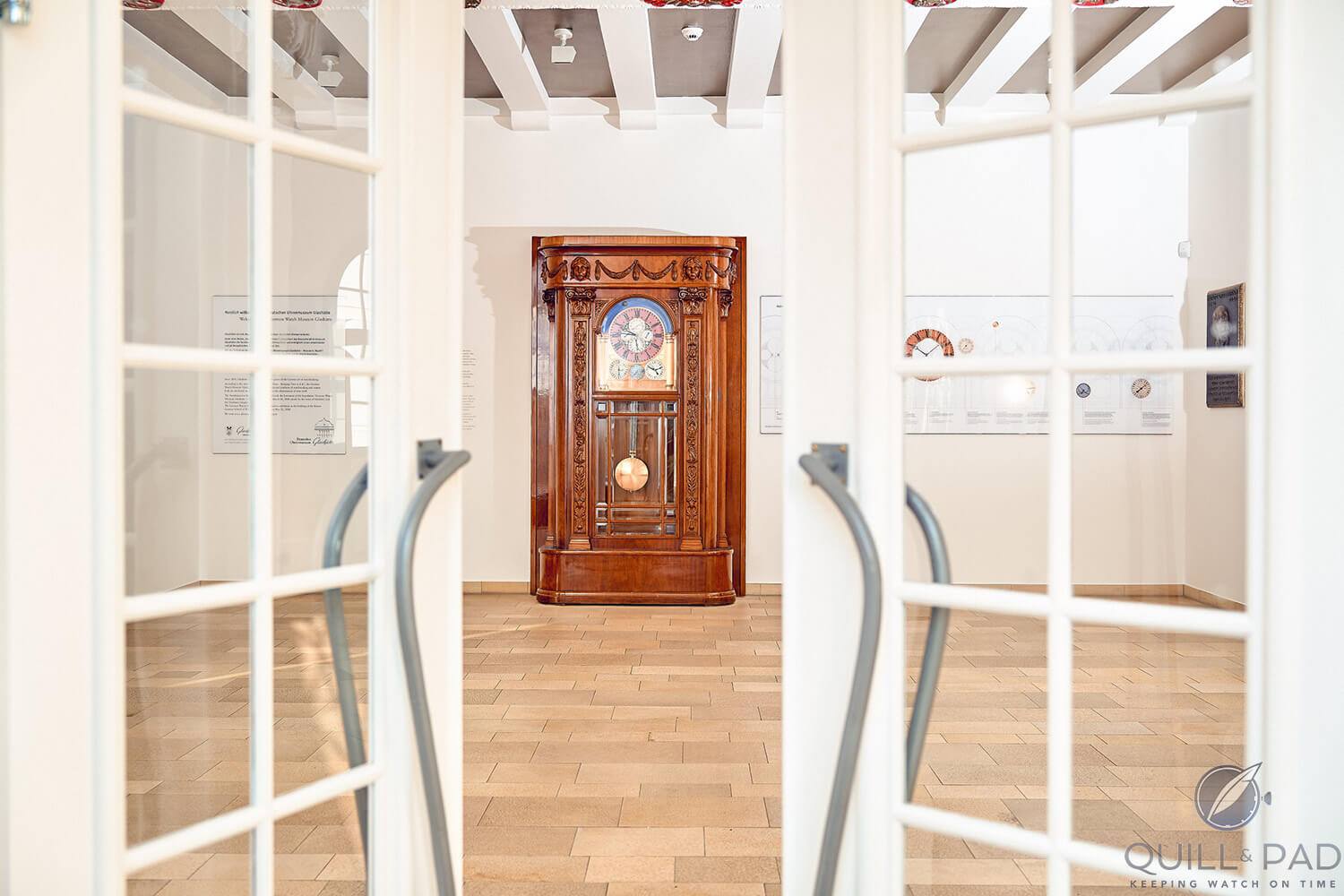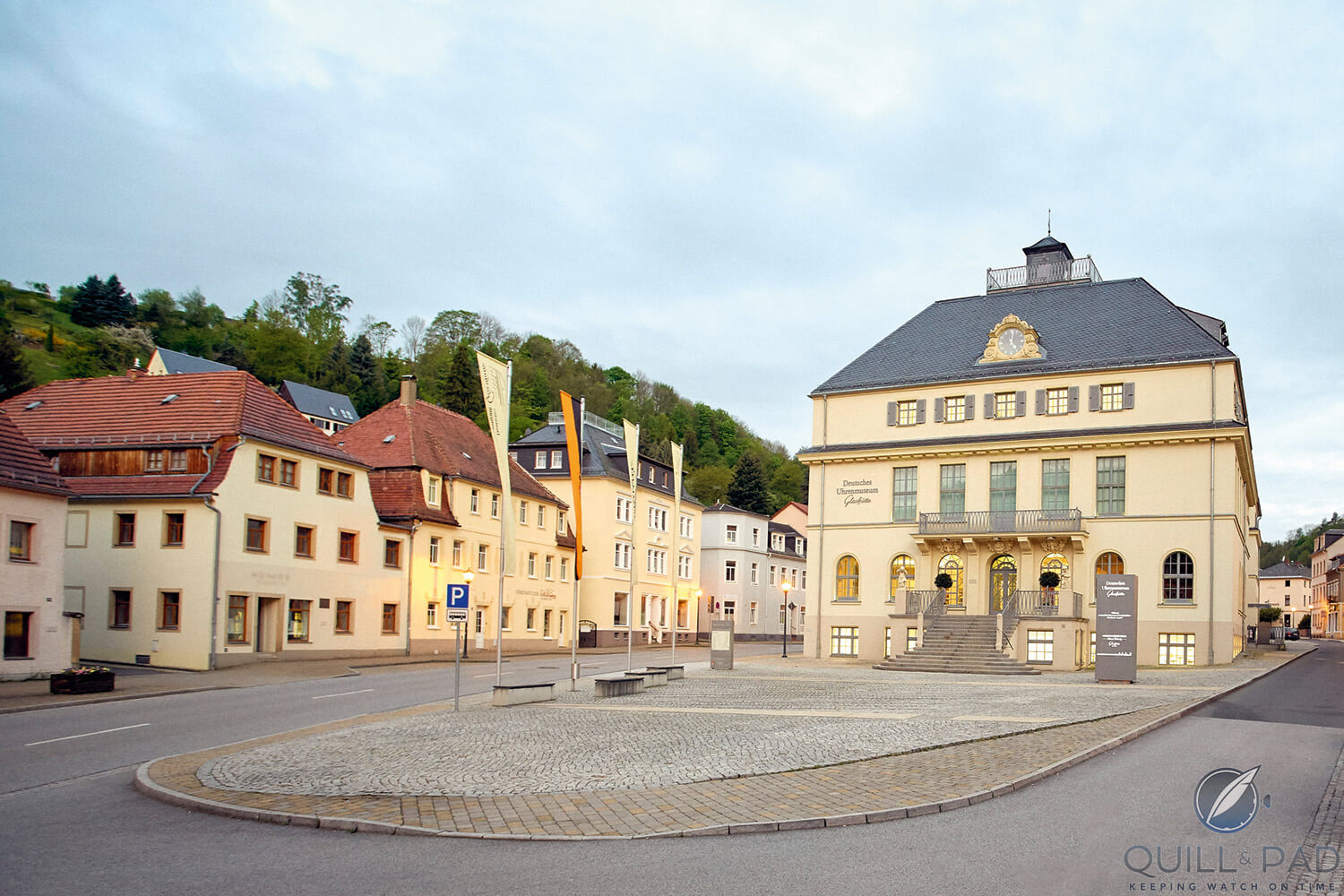March 16, 2006 was the memorable day when the city of Glashütte finally agreed on a worthy role for the its last unused historical building in the city center, the former German School of Watchmaking.
Following a call from the city in 2005, each of the local watch companies were invited to submit a proposal for the former German School of Watchmaking building, which was built in 1881. The brands included A. Lange & Söhne, Glashütte Original, Nomos Glashütte, Mühle Glashütte, Bruno Söhnle, and various component suppliers.

German Watchmaking Museum building in 2006 before renovation
After careful deliberation, then-mayor of Glashütte, Frank Reichel, chose the concept submitted by Glashütte Original, which was backed by the Swatch Group, for a reported sum of 10 million euros (about $13 million). The final classes taught in the historical school took place in 1992, and the building was sorely in need of renovation.
Glashütte Original’s proposal
Glashütte Original’s proposal was for the establishment of a foundation by the same name as the new building: German Watch Museum Glashütte – Nicolas G. Hayek. This foundation was entrusted with the renovation and maintenance of the new museum building, which opened its doors to the public in 2008.

German Watchmaking Museum in 2018 post renovation
The museum’s modern exhibitions, aimed at making watchmaking (and Glashütte) something of a personally experience, has made the new museum interesting for experts, connoisseurs, and the general public. Educational and entertaining hands-on exhibits reside alongside historical objects within the museum.

The astronomical Hermann Goertz clock on display in the contemporary setting of the German Watchmaking Museum in Glashütte
The museum comprises an exhibition space of 1,000 square meters, archives, restoration space, and a public library. Furthermore, Glashütte Original opened a “transparent workshop” in the building.

Colorful 1970s watches from East German Glashütter Uhrenbetrieb on display at the German Watchmaking Museum in Glashütte
Since opening to the public ten years ago, the museum has attracted approximately 365,000 visitors from a total of 114 countries.
The German School of Watchmaking
The German School of Watchmaking (usually known as the DUS, short for “Deutsche Uhrmacherschule”) was founded on May 1, 1878 in Glashütte.
The initiator of the project was Moritz Grossmann, a member of the inner circle of Ferdinand Adolph Lange, founder of the Glashütte watch industry in 1845.
Grossmann was a very learned man, concentrating more on publishing and educating than founding companies. The early years of Glashütte were very, very dependent upon training new watchmakers, and so it became of urgent interest for the industry’s founding fathers to create a system of education in the area. The first three school years (1878-1881) were held in the city’s community school house.

Moritz Grossmann pocket watch circa 1880 on display at the German Watchmaking Museum in Glashütte
Grossmann used an important tool to further his new school, one that Glashütte Original is also presently utilizing: the foundation. The first of these foundations was called to life on January 14, 1881, and its express goal was the erection, maintenance, and financing of the school’s building. A short five months later, the building was already inaugurated, though it was a great deal smaller than its present incarnation, which was extended in 1922-23 to a full 1,000 square meters of teaching rooms and 400 square meters of dormitory space for students and teachers on the uppermost floor.
On January 23, 1885 Grossmann passed away, and to honor him his contemporaries called yet another foundation to life: the goal of the Moritz Grossmann Foundation was to support students of the German School of Watchmaking with scholarships and awards.
The end of World War II brought many dramatic changes to Glashütte. Not only was the A. Lange & Söhne factory destroyed by an air raid just hours before the war was officially declared over, the city ravaged by Russian soldiers, and all companies herded into combines at the beginning of the “Democratic” Republic, but the year 1951 also brought the last set of exams according to the traditional teaching plan.
In that year, the school was integrated into the “state combine system,” and the classic German School of Watchmaking had thus ceased to exist. It was renamed the School for Precision Engineering and Watch Technology Glashütte, and renamed again in 1957 to become the Engineering School for Precision Engineering Technology Glashütte.

A Julius Assmann pocket watch Inside the German Watchmaking Museum in Glashütte
Modern watchmaker education in Glashütte
Germany’s reunification in 1989 once again brought new order to Glashütte, privatizing the Glashütter Uhrenbetrieb (GUB) combine, thus bringing the brand Glashütte Original into existence and returning a number of the historical names back to their rightful owners.
The school’s teaching plans were once again altered to fit into the existing West German system. Due to the fact that East Germany’s planned economy had let the building fall into disrepair, the school’s edifice could only have been resuscitated had a non-state entity shown interest. At that point in time, however, the successful renaissance of Glashütte’s watchmaking industry could not have been foretold.
Today, Glashütte’s public school of watchmaking is named the Dippoldiswalde Trade School Center, Glashütte branch (though it is still called “Makarenko” by the area’s residents, an allusion to the nickname it received during the GDR era in honor of Anton Semyonovich Makarenko, a communist thinker and educator). This school is located a kilometer or two outside the town center.
This is not to say that watchmaker education in Glashütte has declined. Since the renaissance of the town’s primary industry, the big players have all indoctrinated their own educational models to make sure that the art of haute horlogerie watchmaking will not be in danger of dying out again in the city.
A. Lange & Söhne has its own apprentices, taking on 12 each year. Glashütte Original founded its own Alfred Helwig School of Watchmaking, which also takes on 15 new apprentices annually. Independent player Nomos also takes on new apprentices every year, working in conjunction with Makarenko for the theoretical side – as do the bigger companies at home in the Saxon city.

German Watchmaking Museum in the center of Glashütte
The German School of Watchmaking’s original building should remain for posterity thanks to its new purpose: serving as the collective memory of one of the most grandiose histories in watchmaking. Starting with ten years of successfully welcoming guests to Germany’s center of high watchmaking.
For more information, please see www.glashuette-original.com/brand/museum.
You might also enjoy Saxon Watchmakers At Baselworld 2018: The Watches TV Illustrates Fine German Watchmaking In Video and/or Made In Germany: The Glory Of Glashütte.
Leave a Reply
Want to join the discussion?Feel free to contribute!





















































Thanks for sharing such useful topic.